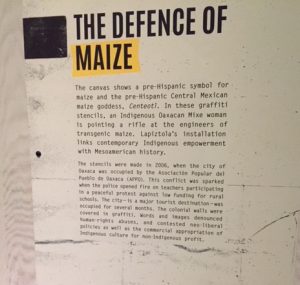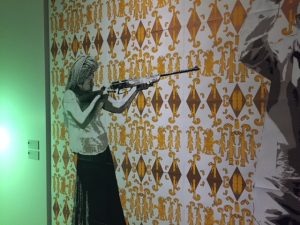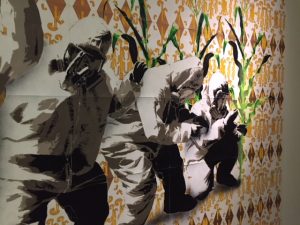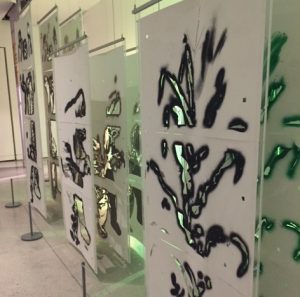This week my ASTU class wrote blog posts regarding the Arts of Resistance exhibit at MOA curated by Laura Osorio Sunnucks. This exhibit highlights the resistance of the Indigenous people in Latin America through art. While reading my classmates’s blogs and while I was walking through the exhibit, I began to wonder: How does the portrayal of art affect the observer’s position on the topic?



The Defence of Maize
The Defence of Maize was described and analyzed by many of my classmates. In Moha’s blog, she explains the “economic exploitation of Indigenous Communities” taking place with the emergence of genetically modified corn in Mexico. This transgenic corn is taking over the market and making the traditional practice of growing Maize unprofitable for these people. In addition to the economic impact on Indigenous people, Tracy explores who “owns” the monetary and historical rights to the Maize. Her analysis describes the woman holding the rifle rightfully demanding what belongs to her and her people. This introduction of transgenic corn challenges not only their economy, but challenges the whole basis of their culture as Joline explains. She points out that maize has a “deep cultural value for the Indigenous people.”
Going back to my original question: How does the portrayal of art affect the observer’s position on the topic?
The Defence of Maize was presented with the stencils right next to it (pictured below). This allows the visitors of the museum to see the process of the art being made which gives us a more realistic view of the art. I looked at the art piece differently after reading the small description paragraph because I had a better, fuller understanding of what I was looking at.

On the other end of the spectrum, there’s William’s blog post. William argues that the resistance of genetically modified corn on a violent level is unjustifiable. He does acknowledge the traditional value of maize to the Indigenous communities. However, he considers the scientists as the innocent ones in this situation. According to William, they are the ones trying to make the world a better place and the violent reaction of the Indigenous woman holding a gun is questionable. What really interests me about William’s blog post is his consideration of the portrayal of the situation. “The exhibit… portrays transgenic maize in a negative light.” This brings me back to my opening question: How does the portrayal of art affect the observer’s position on the topic?
As I read through my classmates’s posts on The Defence of Maize, I noticed that all of them except William sided with the Indigenous people. Perhaps this is because the description of this display noted only the negative impacts of the transgenic corn. Would my classmates have responded differently if this piece had shone more light on both sides of the story?
Connection to Stories We Tell
Something else many of my classmates wrote about was a connection from this exhibit to Sarah Polley’s film “Stories We Tell”. This film explores collective memory and personal identity through the use of interviews, staged footage, emails, narration, and behind-the-scenes action. Azumi considers the fact that the pieces in this exhibit may not reflect the reality as they were specially chosen for the purpose of showing resistance. This is similar to editing the film, where Polley decides which pieces are most important to show, therefore not showing the entire story. However, Mirella discusses the value of this depiction of reality. She explains how the use of different mediums, perspectives, and visuals aids the portrayal of reality in both the film and the exhibit. Perhaps “editing” is a necessary part of conveying the truth.
We are so easily influenced
I thought it was interesting how the artwork Piraq Causa that Daniel describes is asking the same question that I am. As Daniel explains, Piraq Causa means, “Who is to blame?” in the Quechuan language although the artwork does not actually answer this question. Instead, the piece explores the fact that we often focus on what the media is telling us, to find someone to blame, rather than acknowledging the victims. I find this relates so much to my question: How does the portrayal of art affect the observer’s position on the topic? What I interpret from Daniel’s description of Piraq Causa is that we are so easily swayed by the media, someone else’s perception of reality, instead of our own view. In the exhibit, I likely adopted many of Laura Osorio Sunnucks’s opinions simply because she is the one portraying the situation along with the help of various artists.
Conclusion
In summary, it is clear to me that while the main purpose of the exhibit is to educate Canadians on this movement, it also positions the visitors of the exhibit on the side of the Indigenous people of Latin America. Laura Ossorio Sunnucks, the curator, wants us to empathize with these oppressed people and to support their resistance. Arts of Resistance is a great example of art that has a greater influence on the observer by presenting it in a certain manner. The use of descriptions, audio, colour, lighting, and location all helped Sunnucks portray the resistance of Indigenous people in a more “convincing”, thought-provoking, and emotional way. Because we are looking through Sunnucks’s perspective in this exhibit, it is the only one we are exposed to and therefore the only one that forms our opinions (unless visitors have outside knowledge, which many young Canadians on this topic do not).
My advice: When introduced to a new idea or public issue, do some research before developing your opinion. Also note that it is totally okay to change your opinion!
Post-Conclusion Homework (Yay!)
I’ll leave you with some questions to ponder over the weekend:
If our interpretation of art is dependent on the way it’s presented, can it be a reliable source of information? This can be further expanded into the political realm: Must we be educated on a topic before we can form a personal opinion? How can we be certain that our own opinions are formed objectively? Do we require unbiased information when forming our opinions?
Enjoy the pondering!
-Meghan
Check out my blog, posts will be coming soon:)
